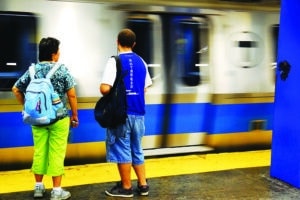
A recent wave of high-end housing developments in Revere has shifted the conversation to production of affordable and workforce housing, potentially including several large public parcels near transit.
Massachusetts Gateway Cities’ real estate revitalization stories often include modest proposals for housing above Main Street storefronts or piecemeal conversions of vacant mills into loft apartments and condominiums.
Revere has a different set of circumstances that reflect Greater Boston’s ever-pricier housing market and the appeal of waterfront properties, fueling demand for high-end housing and shifting the conversation to gentrification and displacement.
Mayor Brian Arrigo sees a pair of MBTA properties as a potential source of thousands of housing units that could be constructed steps from Blue Line stations.
“Those are huge opportunities for mixed-income and affordable housing on public transportation,” Arrigo said last week. “It’s a no-brainer, and we are fully committed to seeing that happen.”
The two parking lots at Beachmont and Wonderland stations total more than 7 acres, and could be combined with neighboring parcels to maximize development potential, Arrigo said.
The idea has a precedent in the recent development of the 230-unit Ocean 650 apartments on a 1.6-acre portion of the Wonderland station lot, noted Tom Skwierawski, Revere’s chief of planning and community development.
The city also may have excess land for public-private development partnerships at the former Wonderland Park property on VFW Parkway. Revere officials selected the over-30-acre property as the location for a new high school last year, but the site could potentially accommodate additional private development, Arrigo said.

Revere officials are hoping MBTA-owned parking lots near the transit agency’s Wonderland subway and bus terminal can host significant new affordable housing development.
Proposal Could Fit into Healey Housing Agenda
Gov. Maura Healey has spotlighted the potential for surplus state-owned property dispositions as part of the solution to Massachusetts’ housing affordability crisis.
Prioritizing housing development could generate pushback from the MBTA, said Andre Leroux, director of the Gateway Hubs project at public policy think tank MassInc.
“There’s a desire to maximize the revenue because of the financial situation that the T is in, which leads to trying to get the maximum sale price for any property that gets sold,” Leroux said. “That runs counter to building affordable housing near transit.”
Revere isn’t required to create new multifamily zoning districts in line with the state’s 2021 Housing Choice law because of its sufficient existing multifamily stock near its three subway stations.
But a future combination of mixed-income and transit-oriented development would benefit a Gateway City like Revere, Leroux said.
“There’s been a bifurcation in the Gateway Cities around metro Boston, which have had a much hotter real estate market and are dealing with gentrification and displacement, and the ones that are further away,” he said. “So, it makes a lot of sense to build housing around the stations.”
In recent years, more than 2,500 market-rate housing units were completed in Revere, many at developments featuring ocean views, high-end amenities and rents to match. The Ocean 650 complex across from Revere Beach currently lists one-bedroom units starting at over $2,700 a month.
New developments aren’t the only ones fetching higher rents. According to a recent ApartmentList report, median rents in Revere have risen nearly 8 percent since January 2022, to $1,565 for one-bedroom units and $1,943 for two-bedroom units.
Inclusionary Development Policy Rejected
Unlike nearby Gateway Cities such as Chelsea, Everett and Malden, Revere doesn’t require a minimum percentage of affordable units in new multifamily developments. In July 2022, city councilors rejected Arrigo’s proposal for a 12 percent minimum of income-restricted units in new developments with more than six units.
The lack of an affordability requirement also applies to the 2,900 housing units planned on the Revere section of HYM Investment Group’s redevelopment of the Suffolk Downs racetrack property. In September, HYM received $150 million in construction financing for the first residential building in Revere, the 475-unit Amaya complex.
On the Boston portion of the 161-acre property, HYM agreed to set aside 13 percent of the 7,000 housing units as affordable, or 900 on-site units, and contribute $5 million to a fund that will acquire and maintain affordable apartments in the surrounding neighborhood.

Steve Adams
Arrigo pointed to one recent win for housing affordability in Revere with last summer’s approval of an accessory dwelling unit ordinance. It allows creation of one- and two-bedroom apartments within owner-occupied single-family homes in four residential zoning districts.
Redevelopment of the MBTA properties would require a complex series of agreements and coordination among public agencies and private developers, and likely a lengthy timeline. The Ocean 500 development was part of the larger Waterfront Square project, which included land swaps between city and state agencies and construction of a new MBTA parking garage to replace surface parking.
But the payoff could be worth the wait, with a short list of private development parcels suitable for large-scale projects beyond Suffolk Downs.
Catherine Rollins, director of the Urban Land Institute Boston/New England, said public parcels remain an untapped tool in the Gateway Cities’ playbook.
“Using public properties for housing production can be one of the things that really unlocks development in places where it can be tricky,” Rollins said. “It can be easier to develop multifamily residential of a certain density and height in the closer-in cities that are accustomed to it.”




 |
| 
